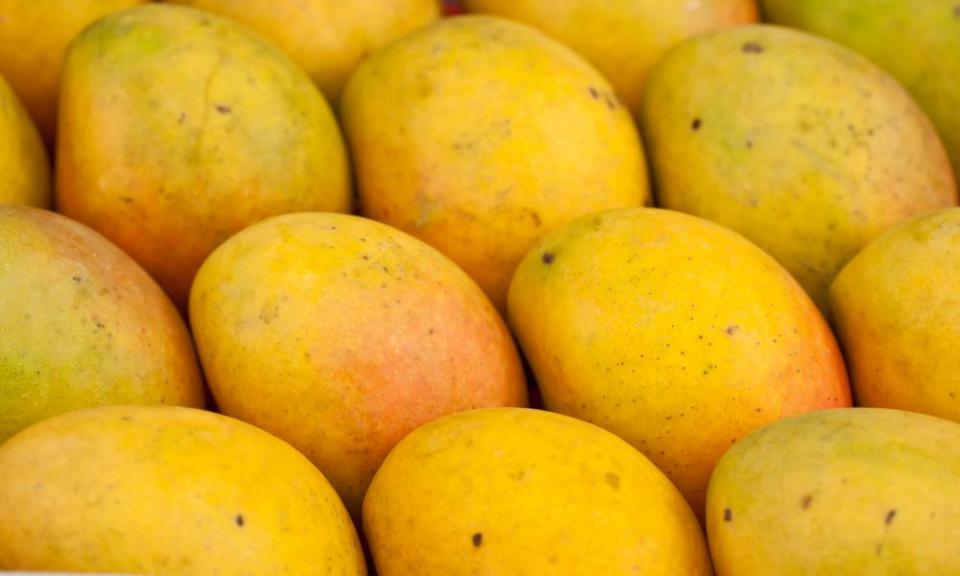Mangoes in July: how growers coax a summer crop to fruit in winter

Leo Skliros is happiest when he’s among his trees picking mangoes with a pole – especially in July. He also loves fishing. For many, the fruits of these activities could be quite a gamble. But for Skliros, not only is the fishing good in his area; he has his mangoes worked out as well.
Skliros, who is president of the Northern Territory Mango Industry Association, is one of the state’s mango farmers who can get their trees to flower and produce mangoes early, when the luscious tropical fruit is a winter luxury and attracts higher prices, making them competitive with the established Queensland market.
Added to that, he grows Kensington Pride mangoes – highly coveted in Australia for their sweet, juicy flesh, but temperamental to grow. How does he do it, when mangoes normally produce fruit in late September – in a good year?
“It’s a bit like KFC, they say,” explains Skliros. “Eleven herbs and spices are the secret recipe and there’s a lot involved in it.” Digging a bit deeper, it’s not a complete mystery. “Many of the growers have what they believe is their own secret recipe but it’s just the variants of what they do around the world.
“It’s all about timing. You’ve got to be in the right place at the right time.” Just about everything you do can affect the outcome, but timing of fertilisers and pruning are critical, he adds. It’s complex, but Skliros does reveal that certain fertilisers are used to lower nitrogen and lift calcium levels, and when cooler nights slip in, potassium nitrate can be sprayed to encourage flowering.
Tim Elliott from Red Rich Fruits says timing of fertilisers is also influenced by moon cycles, atmospheric pressure and temperature fluxes, which can make a difference between flowering or flushing into leaf.
Other variables include location – particularly within regions with variable microclimates – along with water, biosecurity and the tree’s health. A tree must have enough energy to flower, hold the flowers and carry them through to full, quality fruit.
Surprisingly, Elliott says, some trees produce prolifically in rocky regions. Unable to send their roots out, growers have more control over timing of nutrient delivery with fertilisers, and thus flowering.
“Now all these things can play a part in creating an early season or later season fruit,” he says.
Some farmers use cincturing (cutting a ring around the tree’s trunk) to promote flowering, although that can affect the tree’s health, according to Elliott. Another tactic Skliros mentions is bonsaiing the trees. In addition to mechanical pruning this involves chemicals that target the roots and keep the size of the trees more manageable so they don’t grow too fast, too high or too vigorously.
One of our growers ... had carcasses of barramundi hanging ... it looked like Deliverance but the pollination was great
Tim Elliott, Red Rich Fruits
Insects are another critical variable – non-beneficial and beneficial. Sometimes insecticides are used if there’s an outbreak of pests, especially when buds start opening. Then there are the all-important pollinators that come and do their job once the trees have flowered.
Researchers have discovered that flies tended to be the most prolific pollinators of mango trees, followed by various bee species, beetles, ants, butterflies and moths. Armed with this information, Elliott says growers experiment to find what works best for them, with some rather creative outcomes.
“I visited one of our growers at one stage who worked on a fishing trawler,” he says. “He had carcasses of barramundi hanging on every second tree, and it looked like Deliverance but the pollination was great.”
It boils down to lots of trial and error and learning to read the trees. “If you think the tree’s about to push a flower there are ways people have worked out how to do that,” says Elliott. “So instead of one flower, you’ve created a hundred flowers early.”
While this has created a niche market for growers, will these tricks and techniques make winter mangoes, which attract up to $70 a tray in high-end fruit shops, more accessible in the future?
Elliott hopes not. “Early mangoes should always be a luxury item.”

 Yahoo Finance
Yahoo Finance 